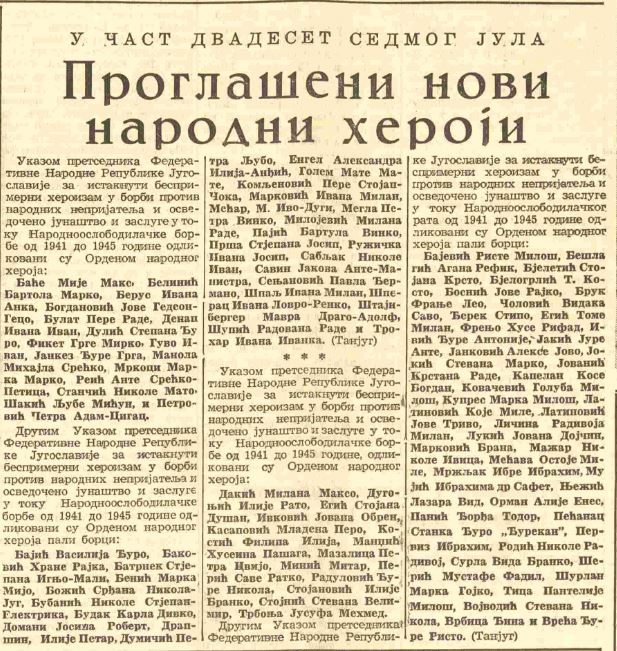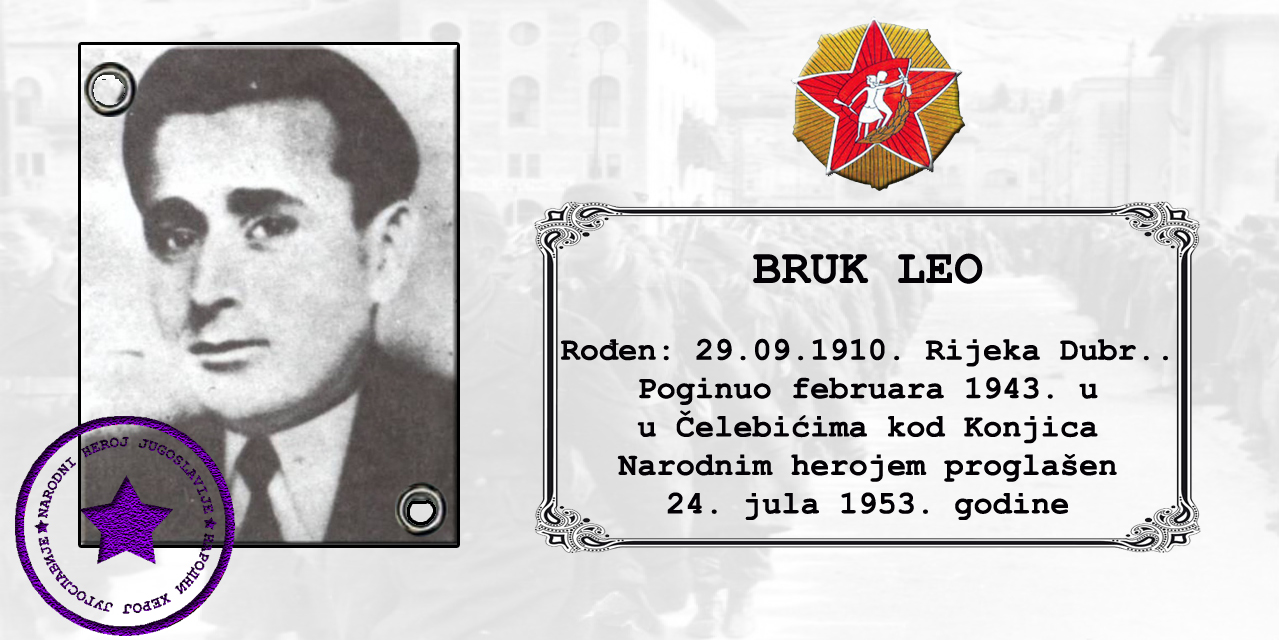
brochure "Partizanski spomenik u Mostaru" (1980)
book “Spomenica Mostara 1941-1945.”
another document or proof of the memorial stone (e.g., a photograph).
Leo F. BRUK, national hero
LEO BRUK, son of FRANJO, born on September 29, 1910, in Rijeka Dubrovačka, in a family of teachers. After the end of World War I, his family moved to Mostar. He learned the trade of a waiter and as a young worker, he joined the revolutionary movement and became a sympathizer of the Communist Party of Yugoslavia (KPJ) in the years leading up to the start of World War II.
During the April War in 1941, as assigned by the KPJ, he, as a Croat, joined the “Maček’s Protection” units, where he worked on specific tasks. It was during this time that Mostar fell into the hands of the Ustaše, mostly peasants led by Ustaše Frankists, who disarmed and arrested Yugoslav soldiers, Serbs, and Communists at the city’s approaches, barracks, and railway station. During those days, waiter Leo Bruk, wearing an Ustaše emblem on his cap and armed, awaited and “arrested” Communists at city intersections, leading them to safe hideouts. This was Leo’s partisan duty.
He worked on gathering weapons and equipment left behind by the Yugoslav army, part of which he hid in a base behind his house and later handed over to members of the National Liberation Army (NOP). He actively participated in NOP actions in occupied Mostar, and in 1941, he became a member of the Communist Party of Yugoslavia. In December 1941, together with two comrades, he distributed party leaflets throughout the city and fell into a police ambush. Leo managed to overpower one of the policemen, take his pistol, and escape. After this incident, Leo could no longer stay in the city and had to join the partisans in the Konjic Battalion (later named Mostar Battalion), which operated in the upper course of the Neretva River.
Already in the early battles, at the beginning of 1942, he distinguished himself as a brave and capable fighter, which soon led to his appointment as the commander of the Third Company. He was also entrusted with the most difficult and responsible tasks. After the Third enemy offensive in July 1942, the battalion headquarters sent him, along with two fighters, as a courier to the Supreme Headquarters of the National Liberation Army and Partisan Detachments, where he had the opportunity to personally meet Tito and encounter fighters from the First Proletarian Shock Brigade, from whom they received the heavy machine gun “Breda.” After that, under difficult conditions, he returned to the battalion. In August 1942, the Mostar Battalion was incorporated into the newly formed Tenth Herzegovinian Shock Brigade.
As the political delegate of the machine gun platoon, he distinguished himself in battles during the Fourth enemy offensive, at Jajce, Žepče, and Prozor. For a period of time, he served as the battalion commander, and after the capture of Prozor in February 1943, a tank unit was formed at the Headquarters of the Third Shock Division. Leo, along with several other distinguished fighters from the Tenth Herzegovinian Brigade, was transferred to this tank unit and appointed as a machine gunner on a tank. The units of the Third Shock Division – the Tenth Herzegovinian, Fifth Montenegrin, and First Dalmatian Brigades – launched an attack on German and Chetnik forces in Konjic. After several consecutive attacks and due to the deteriorating situation near Prozor, the attack was halted on February 26. In these battles, the tank unit of the Third Shock Division, in which Leo was located, operated under the direct command of the Supreme Headquarters.
He was killed on February 26, 1943, as the leader of a tank and a machine gunner in the battles near the village of Čelebići, near Konjic. By the decree of the President of the Federal People’s Republic of Yugoslavia, Josip Broz Tito, on July 24, 1953, he was proclaimed a People’s Hero. According to the accounts of his comrades, he “remained in the eternal memory of his comrades because of his personal courage, sociability, sincerity, and the modesty of a fighter and proletarian.”
In Mostar, on Balinovac, there used to be a bust of Leo Bruk, which was removed before the last war.
Leo Bruk is the older brother of Mladen Bruk.
Ćemalović, Enver (1986): Mostarski bataljon, Mostar; Leo Bruk – Narodni Heroj Iz Dubrovnika ( Hrvatska ) (yu-nostalgija.com); grupa autora (1961): Hercegovina u NOB 1. dio, Beograd, Vojno delo ; Leo Bruk – Narodni Heroj Iz Dubrovnika ( Hrvatska ) (yu-nostalgija.com) ; Seferović, Mensur (1961): Prozivka na Tjentištu, “Veselin Masleša”, Sarajevo; grupa autora: Spomenica Mostara 1941-1945; https://sr.wikipedia.org/wiki/%D0%9B%D0%B5%D0%BE_%D0%91%D1%80%D1%83%D0%BA; Seferović, Mensur (1957): „Tajna partijske ćelije“, Sarajevo; Seferović, Mensur (1970): Pred očima grada, »Informativni centar Mostar«, nagrada »14. februar« Skupštine opštine Mostar, 1970.; grupa autora (1961): Hercegovina u NOB 1. dio, Beograd, Vojno delo; https://www.oslobodjenje.ba/vijesti/bih/povratak-narodnih-heroja-na-ulice-449064 Photo of the memorial plaque: S. Demirović, https://www.klix.ba/vijesti/bih/zasto-nekima-smeta-partizansko-groblje-u-mostaru-i-sta-to-znaci-za-drzavnost-bih/201124140; Narodni heroji Jugoslavije A-M, Institut za savremenu istoriju, Partizanska knjiga, Ljubljana, Narodna knjiga, Beograd, Pobjeda, Titograd, 1982.
Do you have more information about this fighter? Share your stories and photographs. Let's keep the memory alive!








